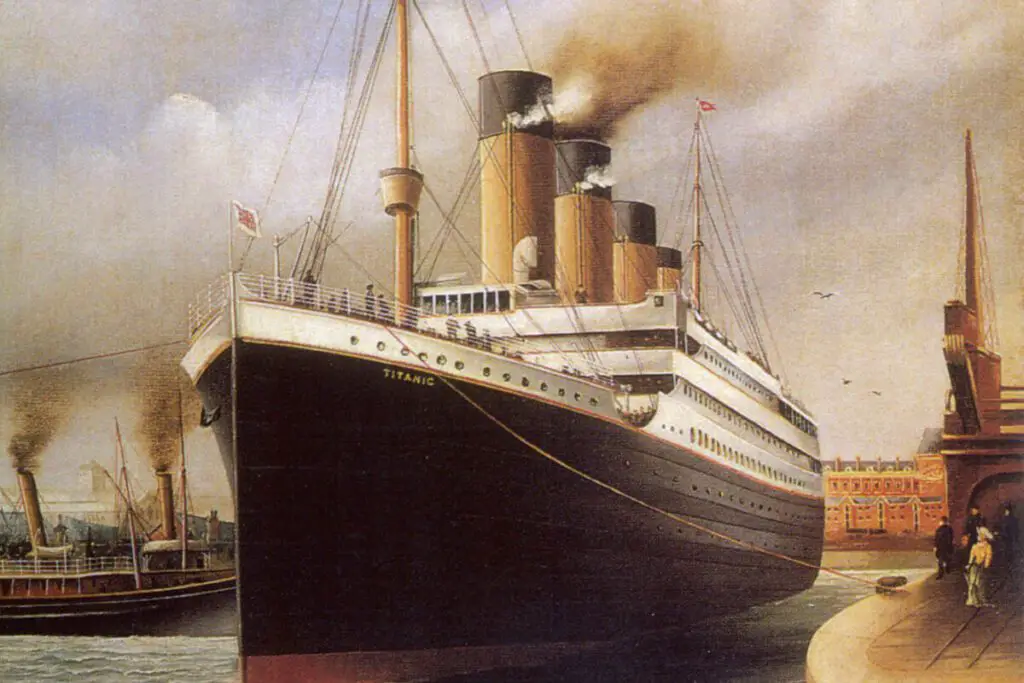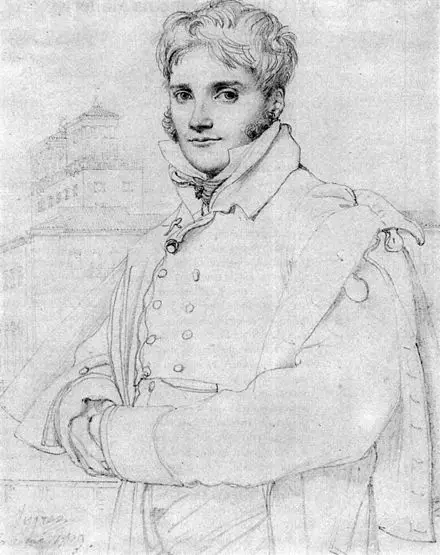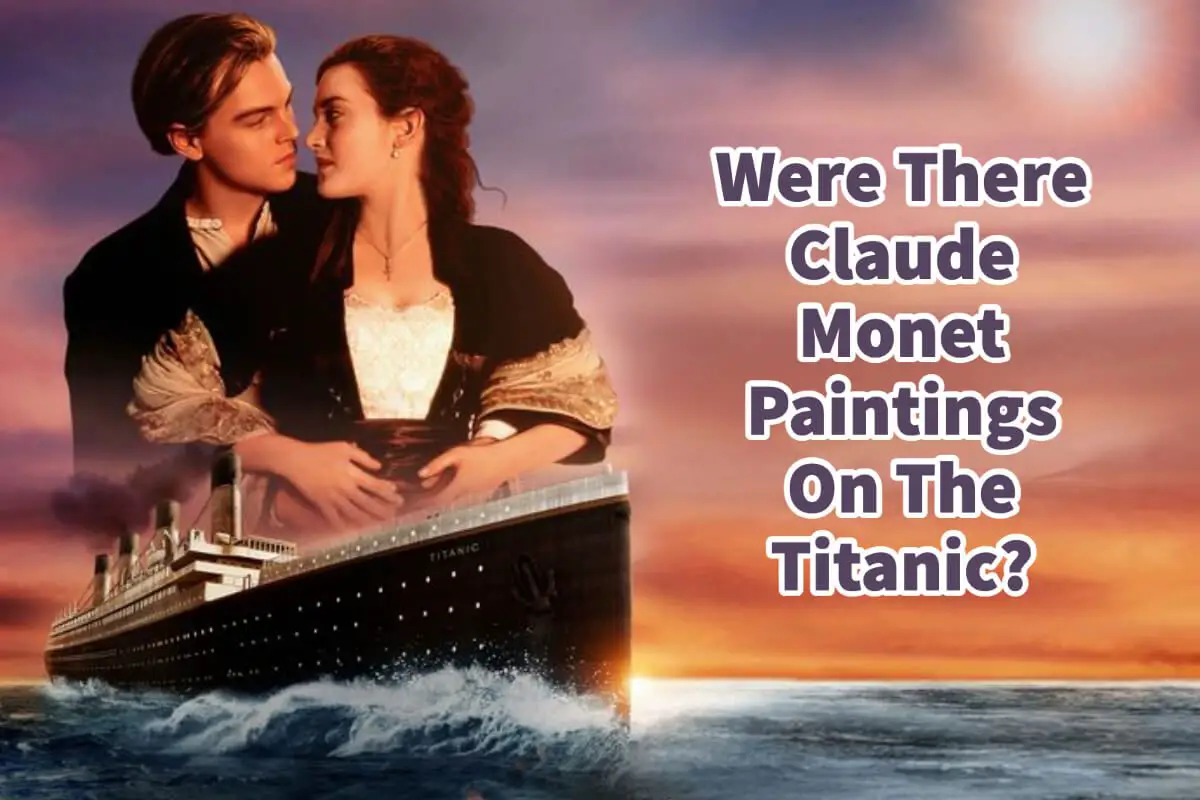The tragic Titanic accident was one of the most fateful boating accidents. When you watch the famous Hollywood movie Titanic, one of the main stars, Rose (Kate Winslet), has an extensive art collection of the Titanic with her, including some paintings by Claude Monet.
On the actual Titanic ship, there is no evidence that any paintings by Claude Monet were lost when the Titanic sank into the depths of the sea. The most valuable insurance claim for the sinking of the Titanic was for a painting called La Circassienne au Bain (1814) By Merry-Joseph Blondel.
Table of Contents
- No Claude Monet Paintings Were Lost On The Titanic
- La Circassienne au Bain (1814) By Merry-Joseph Blondel Was Lost On The Titanic.
- 10 Reasons Behind Claude Monet’s Enduring Popularity
- Frequently Asked Questions
- Related Questions
No Claude Monet Paintings Were Lost On The Titanic
The RMS Titanic was a British passenger liner that White Star Line operated, a shipping company based out of England. The Titanic was said to be a vessel that was so well-built that it was utterly unsinkable.

On the Titanic’s maiden voyage on 15 April 1912 from Southampton, United Kingdom, to New York City in the United States, the Titanic struck an iceberg, which caused the ship to sink. Of the estimated 2,224 passengers and crew on board, only 710 survived, or more than 1,500 died; the Titanic was one of the largest peacetime sinkings of a superliner or cruise ship.
When the Titanic left the harbor, of the 1300 passengers, about 319 were in first-class cabins. Those passengers brought on board with them their jewelry, art, and even motorcars.
When the Titanic sank, not only did the passengers lose their lives, but all the cargo was also lost. There were no Claude Monet paintings on the Titanic, but a painting called La Circassienne au Bain (1814) by Merry-Joseph Blondel.
La Circassienne au Bain (1814) By Merry-Joseph Blondel Was Lost On The Titanic.

Painting by Merry-Joseph Blondel (Reproduced copy)
La Circassienne au Bain, an early 19th-century oil painting by French Salon master Merry-Joseph Blondel, sank on the Titanic’s fatal voyage in 1912. The painting was brought on board the Titanic by Mauritz Hakan Bjornstorm-Stefansson, a 29-year-old Swedish wood pulp heir.
On the fateful day of 15 April 1912, Bjornstrom-Stefansson was in the smoking class lounge with Hugh Woolner when the iceberg struck the ship. The two went on deck and started to help others into the lifeboats; just as the boat was ready to be wholly submerged, they jumped onto one of the last lifeboats.
Titanic survivors heaped tons of insurance claims on White Star Line, the owners of the Titanic. Bjornstrom-Steffansson filed a claim for the lost painting for $100,000 (over $2,5 million in today’s dollars); his claim was the largest of the other claims brought by the Titanic survivors.
We do not know how much he got for the painting, but as the White Line Star settled the claims for less than the actual claim amounts, we doubt he received the total amount for his claim, probably about 65% of what he requested.
The painting was not the only valuable thing lost on the Titanic. There was also a signed portrait of Italian nationalist Giuseppe Garibaldi and a bejeweled edition of the Rubaiyat, a Persian book of poetry dating to the 11th Century. But the La Circassienne au Bain painting was the single largest claim for the entire 6 million (about 130 million today) of the claims made to the White Star Line for the loss of the Titanic.

Listen To Our Podcast About Were There Claude Monet Paintings On The Titanic? by clicking here.
About La Circassienne au Bain (1814) By Merry-Joseph Blonde

By His Friend Ingres
La Circassienne au Bain was painted by Merry-Joseph Blondel in 1814. Merry-Joseph Blondel was born in Paris in 1781. From an early age, he showed great promise with art and received many awards and commissions.
Blondel was known to work on the Versailles, the Louvre, and Fontainebleau decorations. Blondel’s French Neoclassical artwork included elegant court portraits and historical and mythological scenes.
Blondel was known for his great attention to detail, lush colors, idealized human anatomy, and dynamic movement.
The painting La Circassienne au Bain has become famous over the last Century partly because it vanished in one of the world’s most famous fateful voyages.
In his insurance claim to White Star Line, Bjronstrom-Stefansson said that the painting was 8 feet by 4 feet, but he did not specify if this included the frame and crate or the painting canvas only. This size was not standardized, so most people believe the canvas size was about 6 feet 5 inches by 4 feet and 3 inches (195 cm by 130 cm).
In 2013, a British artist using the pseudonym of John Parker researched the painting and decided to reproduce a copy of the La Circassienne au Bain. In 2016, the La Circassienne au Bain reproduction was auctioned and sold for $3,500.
10 Reasons Behind Claude Monet’s Enduring Popularity
- Pioneer of Impressionism: Monet was a founding figure of the Impressionist movement, which revolutionized the art world. His innovative approach to capturing light and color had a profound impact on the development of modern art.
- Distinctive Style: Monet’s unique style, characterized by loose brushwork and a vibrant color palette, sets him apart from his contemporaries and continues to captivate audiences.
- Capturing Light and Atmosphere: Monet had a remarkable ability to depict changing light and atmosphere, making his paintings feel alive and dynamic. This quality keeps his work fresh and relevant.
- Innovative Techniques: His technique of painting the same scene at different times of day and in various weather conditions was groundbreaking, showcasing the fluidity and complexity of the natural world.
- Influence on Modern Art: Monet’s work laid the groundwork for subsequent modern art movements, including Post-Impressionism and Abstract Expressionism.
- Emotional Depth: Beyond their visual appeal, Monet’s paintings evoke a sense of tranquility and emotional depth, resonating with viewers personally.
- Iconic Works: Works like “Water Lilies” and “Impression, Sunrise” have gained iconic status, making them and Monet instantly recognizable worldwide.
- Universal Appeal: Monet’s focus on nature and landscapes is universally appealing, transcending cultural and temporal boundaries.
- Exposure and Accessibility: Regular exhibitions and widespread reproduction of his work in various media have kept Monet in the public eye and accessible to a broad audience.
- Legacy and Influence: Monet’s influence extends beyond art; he has impacted fashion, design, and popular culture, ensuring his continued relevance and popularity in the contemporary world.
Claude Monet’s work remains popular because it transcends time and place, offering viewers a timeless glimpse into the beauty of the natural world through the eyes of a master. His legacy continues to inspire and delight audiences, solidifying his place as one of the most celebrated artists in history.
Anita Louise Art is dedicated to art education, great artists, and inspiring others to find and create their art. We love art that uplifts and inspires. #ArtToMakeYouSmile! #ArtToMakeYouHappy!
If you are interested to see any of my art, you can find out more by clicking here. If you are interested in what inspires me and my paintings, you can discover more by clicking here.
We have a free newsletter and would love you to be part of our community; you can subscribe to the newsletter by clicking here. If you have any questions, I would be happy to talk to you anytime. You can reach me, Anita, by clicking here.
Subscribe to our Anita Louise Art YouTube Channel with great videos and information by clicking here.
Join us for our podcast “5 Minutes With Art.” Spend just 5 minutes a week with us to discover and learn about great art and artists. You can find out more about our podcast by clicking here.
Frequently Asked Questions
Was a Monet painting featured in the film Titanic
Yes, a Monet painting was featured in the film Titanic, specifically his painting “Impression, Sunrise.
Was the Monet painting actually on the Titanic ship?
There is no evidence to suggest that the Monet painting featured in the film Titanic was ever on the actual Titanic ship.
What is the significance of the Monet painting in the film Titanic?
The Monet painting featured in the film Titanic is used as a symbol of the luxury and opulence of the ship, and its destruction serves as a powerful metaphor for the tragedy of the sinking.
Did Monet ever paint any maritime scenes or ships
While Monet is best known for his landscapes and seascapes, he did not paint many scenes featuring ships or other maritime subjects.
How has the Titanic been depicted in art over the years?
The Titanic has been depicted in a wide range of artistic media over the years, including paintings, photographs, films, and literature.
How has the Titanic influenced popular culture over the years?
The Titanic has had a significant impact on popular culture over the years, inspiring numerous films, television shows, and works of literature and art, and serving as a potent symbol of tragedy, loss, and human resilience.
What is the legacy of Monet’s work in the history of art?
Monet’s work is widely regarded as some of the most important and influential in the history of art, and his innovative approach to painting continues to inspire new generations of artists today.
How did Monet’s artistic style differ from earlier approaches to painting?
Monet’s approach to painting differed from earlier approaches in that he focused on capturing the fleeting, ephemeral qualities of light and atmosphere, using loose, expressive brushstrokes to convey his impressions of the natural world.
Related Questions
What Are The Similarities Between Claude Monet And Vincent Van Gogh?
Claude Monet is an impressionist artist, while Vincent Van Gogh is a post-impressionist. Despite their differences, they still have a lot in common with their artwork, and they are considered two of the greatest artists who would ever live.
By clicking here, you can learn more by reading What Are The Similarities Between Claude Monet And Vincent Van Gogh?.
Why Is Van Gogh Considered Such a Great Artist?
Many things make Vincent Van Gogh unique and great as an artist. He had a great way to use color in his heart, but more than that, he was an artist who set and paved the way, and his brushstroke technique used color and his design ability. What is interesting about all this he did this as a self-taught artist.
By clicking here, you can discover more by reading Why Is Van Gogh Considered Such a Great Artist?
Claude Monet And His Art Work
Claude Monet was one of the more prolific and consistent Impressionism painters. He was a great believer in painting what was seen in nature and painting the changing light. He was an en Plein air painter. He is known for his strong and bold color and short brush strokes.
You can discover more by reading Claude Monet And His Art Work by clicking here.


